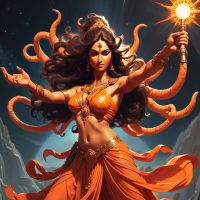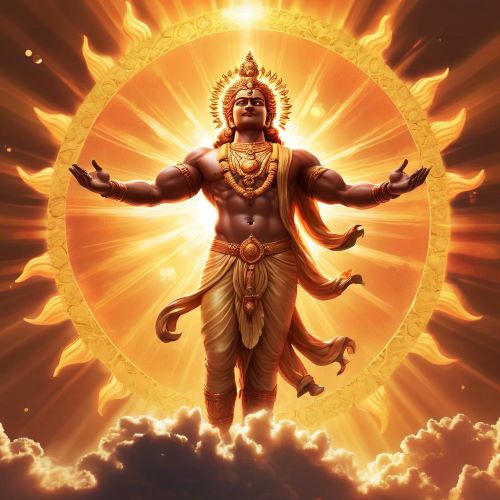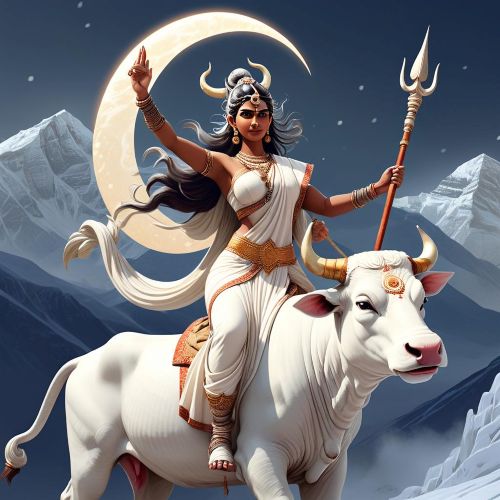Kushmanda : Goddess of Solar Energy
Listen
At a glance
| Description | |
|---|---|
| Origin | Indian Mythology |
| Classification | Gods |
| Family Members | Shiva (Husband) |
| Region | India |
| Associated With | Energy, Creation |
Kushmanda
Introduction
Kushmanda, the fourth manifestation of Goddess Durga, holds a unique place in Hindu mythology as the embodiment of creative energy. Her name combines Ku (a little), Ushma (warmth or energy), and Anda (cosmic egg), symbolizing the subtle spark that gave rise to the universe. Worshipped on the fourth day of Navratri, she is revered as the radiant goddess whose smile dispelled the primordial darkness, giving birth to light, life, and cosmic order. Unlike other deities associated with destruction or preservation, Kushmanda represents the very moment of creation—the power of energy taking form in the cosmos.
Physical Traits
Depictions of Kushmanda emphasize her brilliance and solar radiance. She is often shown with eight or sometimes ten arms, each hand carrying divine weapons and sacred objects such as the trident, discus, bow, arrow, mace, lotus, rosary, kamandalu, and a jar of nectar. These symbolize both her protective powers and her nurturing qualities. Her mount is a lion or tiger, reflecting her courage and supreme command over fear. With a golden complexion glowing like the rising sun, a compassionate smile, and three watchful eyes, she embodies both maternal warmth and divine authority. Artists often portray her with a halo of sunlight, reinforcing her identity as the sustainer of solar energy.
Family
As an avatar of Goddess Parvati, Kushmanda is mythologically connected to Lord Shiva as her consort. Through this divine union, she is linked to Kartikeya, the god of war, and Ganesha, the remover of obstacles. Her role within the divine family places her at the center of cosmic balance—Parvati’s nurturing nature, Shiva’s ascetic energy, and their children’s divine functions all stem from this harmony. In some traditions, Kushmanda’s intervention is highlighted in myths where she revives Surya, the Sun god, ensuring the continuation of cosmic life. This act emphasizes her role not only as creator but also as sustainer of vitality within the divine order.
Other names
Kushmanda is worshipped under multiple epithets that emphasize her many aspects. She is known as Ashtabhuja Devi or Ashta-bhujadhari because of her eight arms. Titles like Adi Shakti and Mahadevi highlight her role as the primordial force and supreme goddess. Another name, Surya Mandala Vasini, points to her dwelling within the solar sphere, underscoring her intimate connection with the sun. Beyond mythology, the term Kushmanda is also used for the ash gourd or white pumpkin (Benincasa hispida), an auspicious fruit in Hindu rituals that symbolizes nourishment and energy. This linguistic and symbolic overlap reinforces her image as the source of sustenance and vitality.
Powers and Abilities
Kushmanda’s most celebrated ability is her power to create life through energy. Her gentle smile is said to have given rise to the sun, infusing the cosmos with warmth and rhythm. She resides within the solar core, regulating its light and movement, which sustains both gods and mortals. Beyond her cosmic role, she blesses devotees with health, courage, and inner vitality, dispelling fear and inertia. Myths describe her reviving Surya when he lost his strength, showing her as both healer and life-giver. Spiritually, she embodies the energy that awakens the heart chakra, inspiring compassion and emotional strength. Her powers extend symbolically into the medicinal realm as well, where preparations derived from the Kushmanda fruit are used in Ayurveda to treat ailments ranging from digestive issues to psychological disorders.
Modern Day Influence
Kushmanda’s influence endures in both devotional practices and cultural traditions. On the fourth day of Navratri, devotees honor her with offerings of pumpkins, chanting her mantras and wearing yellow attire to symbolize vitality and positivity. In yoga and meditation practices, she is associated with awakening the Anahata (heart) chakra, guiding practitioners toward balance and resilience. Her symbolism as the bringer of solar energy has found resonance in modern ecological and spiritual movements that emphasize light, energy, and sustainability.
The ash gourd linked to her name continues to play a vital role in Ayurveda. Preparations such as Kushmanda Ghrita and Kushmanda Avaleha are widely studied for their therapeutic effects, particularly in mental health treatments and gynecological conditions. Modern science has validated some of these uses, highlighting the plant’s antioxidant and medicinal properties. Through festivals, rituals, medicine, and art, Kushmanda remains deeply embedded in contemporary culture, bridging ancient mythology with present-day wellness and spirituality.
Related Images
Source
Wikipedia contributors. (2023). Kushmanda. Wikipedia. https://en.wikipedia.org/wiki/Kushmanda
Indian Mythology Stories. (2023). What is the story behind Goddess Kushmanda? https://indianmythology.co.in/what-is-the-story-behind-goddess-kushmanda/
The Hindu Tales. (2023). Goddess Kushmanda: The Energy Worshipped on the 4th Day of Navratri. https://thehindutales.com/feminine/goddess-kushmanda/
Kinsley, D. R. (1986). Hindu Goddesses: Visions of the Divine Feminine in the Hindu Religious Tradition. University of California Press.
Pattanaik, D. (2010). 7 Secrets of the Goddess. Westland Publications.
Foulston, L., & Abbott, S. (2009). Hindu Goddesses: Beliefs and Practices. Sussex Academic Press.
Dimmitt, C., & van Buitenen, J. A. B. (1978). Classical Hindu Mythology: A Reader in the Sanskrit Puranas. Temple University Press.
Bhattacharji, S. (1990). The Indian Theogony: A Comparative Study of Indian Mythology from the Vedas to the Puranas. Cambridge University Press.
Frequently Asked Questions
What is lorem Ipsum?
I am text block. Click edit button to change this text. Lorem ipsum dolor sit amet, consectetur adipiscing elit. Ut elit tellus, luctus nec ullamcorper mattis, pulvinar dapibus leo.
What is lorem Ipsum?
I am text block. Click edit button to change this text. Lorem ipsum dolor sit amet, consectetur adipiscing elit. Ut elit tellus, luctus nec ullamcorper mattis, pulvinar dapibus leo.
What is lorem Ipsum?
I am text block. Click edit button to change this text. Lorem ipsum dolor sit amet, consectetur adipiscing elit. Ut elit tellus, luctus nec ullamcorper mattis, pulvinar dapibus leo.
What is lorem Ipsum?
I am text block. Click edit button to change this text. Lorem ipsum dolor sit amet, consectetur adipiscing elit. Ut elit tellus, luctus nec ullamcorper mattis, pulvinar dapibus leo.
What is lorem Ipsum?
I am text block. Click edit button to change this text. Lorem ipsum dolor sit amet, consectetur adipiscing elit. Ut elit tellus, luctus nec ullamcorper mattis, pulvinar dapibus leo.












